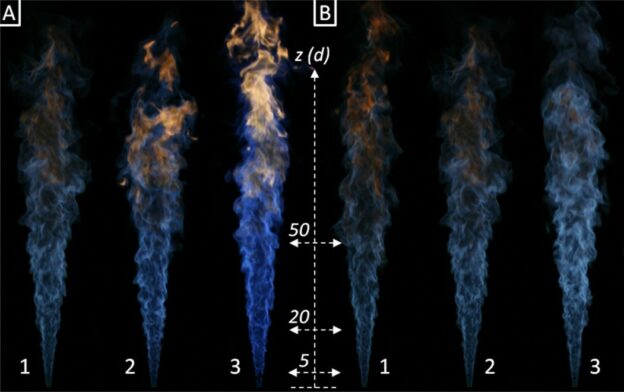Sandia/NTNU
General Description: Two series of flames burning mixtures of methane and hydrogen were investigated. In the first series, the hydrogen molar fraction in the fuel was variedfrom 37% to 55%, with a constant jet exit Reynolds number of 15,000. In the second series the jet exit Reynolds number was variedfrom 12,000 to 18,000, while keeping 55% H2 molar fraction in the fuel. One flame is common to both series. The fuel nozzle had 5-mm inside diameter with 0.5 mm wall thickness and squared-off end. Thanks to the H2 content in the fuel, the flame remained attached to the fuel nozzle. The nozzle had its tip 40 mm above the exit plane of the coflow honeycomb and was long enough so that when the fuel mixture reached the nozzle tip the flow was considered fully developed. The fuel nozzle was surrounded by a laminar coflow with 32% molar fraction of O2 in CO2 and a diameter of 96.5 mm. Measurements were performed at Sandia National Laboratories using simultaneous line imaging of Raman/Rayleigh. The setup enabled measurements of single-shot profiles of temperature and the mass fractions of all major species (CO2, O2, CO, N2, CH4, H2O and H2). The spatial resolution was 0.104 mm along a ~6 mm section of the focused beam. There are no velocity measurements for these flames.
Reference: A. Sevault, M. Dunn, R.S. Barlow, M. Ditaranto, “On the structure of the near field of oxy-fuel jet flames using Raman/Rayleigh laser diagnostics,” Combust. Flame 159 (2012) 3342–3352. http://dx.doi.org/10.1016/j.combustflame.2012.06.017
Please also include a reference to https://tnfworkshop.org in publications.
Primary Contact: Robert Barlow (robertbarlow.bcr@gmail.com)
Acknowledgments: Alexis Sevault was supported by the BIGCO2 project performed under the strategic Norwegian research program Climit. Support for the scalar measurements at Sandia was provided by the US Department of Energy, Office of Basic Energy Sciences, Division of Chemical Sciences.
Data Archive: The zip file is 287 MB and includes the complete data set, a few MatLab scripts to post-process the data, and ReadMe files in most of the folders to explain the content.
